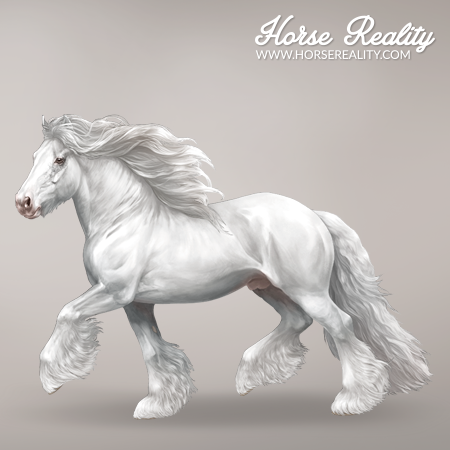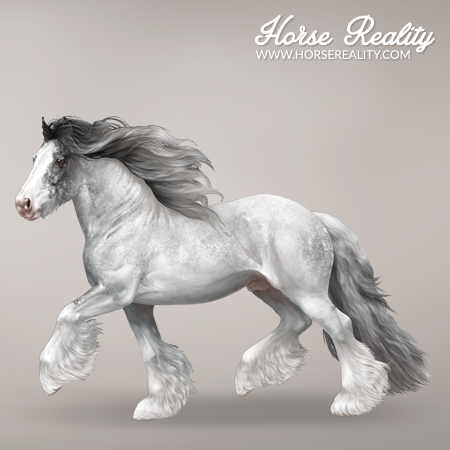Sabino1 is one of the white patterns present in horses.
¶ Phenotype
Sabino1 is a white spotting pattern, characterised by white markings on the legs, often accompanied by white patches on the horse's belly, face and/or entire body. The edges of these markings are typically irregular and jagged. White ticking or “roaning” on the body is also very common. Sabino1 affects any base colour, but the presence of dilutions or grey may make the pattern harder to see.
The white pattern has a high variability of expression: it can be very minimal and difficult to distinguish from regular white markings, or even cause the horse to look almost entirely “white”. Sabino1 horses that have a nearly-white appearance, are usually homozygous. Sabino1 generally does not cause blue eyes.
When a horse has both sabino1 and other white patterns, their characteristics are usually combined and there is generally more white than the individual patterns would cause. For example, having both sabino1 and tobiano may cause the horse to have irregular or “roaning” edges to the coloured patches (as opposed to defined ones), face markings, and white areas on the chest and/or flank; which are normally coloured in tobiano horses.
| Sabino1 - Irish Cob Horse | |

|

|

|

|
The word “sabino” is often used as a general term for white spotting-like patterns. Many different alleles can cause these similar-looking patterns, and only for a selection of them, the genetic cause has been found. Examples of this are patterns seen in breeds such as Akhal-Tekes, Shire Horses or Welsh Ponies. These unidentified patterns are commonly called “sabino” or "hidden/untestable sabino", but they should not be confused with sabino1. In Horse Reality, they are all implemented as hidden sabino.
¶ Genotype
Sabino1 is caused by the incomplete dominant SB1-allele, located on the KIT gene. Horses heterozygous for SB1 have less white than homozygous horses, who often look nearly “white”.
Below, the resulting phenotype of each genotype is listed:
- SB1/SB1 = Sabino1
- SB1/n = Sabino1
- n/n = Not sabino1
The presence of sabino1 can be tested in the Laboratory.
Sabino1 can of course also be present together with other KIT alleles - however, since they are located on the same gene, horses can only be heterozygous:
- SB1/TO = Sabino1 tobiano
- SB1/RN = Sabino1 roan
- SB1/Wx = Sabino1 white spotting x
Sabino1 can be seen as a variation of the many white spotting alleles. Sabino1 was the first one to be discovered and researchers named the responsible allele "sabino1" with the expectation that later alleles would be called "sabino2", "sabino3", etc. They matched the terminology already used by horse breeders, and they also didn’t want to scare or confuse people with connotations based on the OLW gene in horses. However, as more and more alleles were being discovered, they decided to change their naming convention to W1, W2, and so on instead. This was based on the terminology used in mice, where a similar “dominant white” locus is present. These patterns in mice are homozygous embryonic lethal, and the same was initially assumed for horses. Later on, it was discovered that certain W-alleles are viable in the homozygous state. Following this, the name of these alleles was once again changed to “white spotting”.
¶ Breeds
Sabino1 can be found in a variety of breeds, but it is usually relatively rare. The following table lists all breeds that can currently have the sabino1 (SB1) allele in-game:
| Breeds |
| Akhal-Teke Horse |
| Arabian Horse |
| Brabant Horse |
| Brumby Horse |
| Camargue Horse |
| Cleveland Bay |
| Exmoor Horse |
| Finnhorse |
| Fjord Horse |
| Friesian Horse |
| Haflinger Horse |
| Icelandic Horse |
| Irish Cob Horse |
| Kladruber Horse |
| Knabstrupper |
| Lipizzaner Horse |
| Lusitano |
| Mongolian Horse |
| Mustang Horse |
| Namib Desert Horse |
| Noriker Horse |
| Norman Cob |
| Oldenburg Horse |
| Pantaneiro Horse |
| Pura Raza Española |
| Quarter Horse |
| Shetland Pony |
| Shire Horse |
| Suffolk Punch |
| Thoroughbred |
| Trakehner Horse |
| Welsh Pony |
¶ References
- Bellone R., Sponenberg D. P., Equine Color Genetics, 4th Edition, 2017, Wiley-Blackwell
- Brooks S. et al., Studies of genetic variation at the KIT locus and white spotting patterns in horses, 2005
- Stamatelakys I., The Color Inside, 2016, Paint Horse Journal
- UC Davis Veterinary Genetics Laboratory; https://vgl.ucdavis.edu/test/sabino-1; Access: November 2022
- Generatio Center for Animal Genetics; https://generatio.de/en/guidance/lexicon/sabino-1-coat-colour-pattern-horse; Access: November 2022